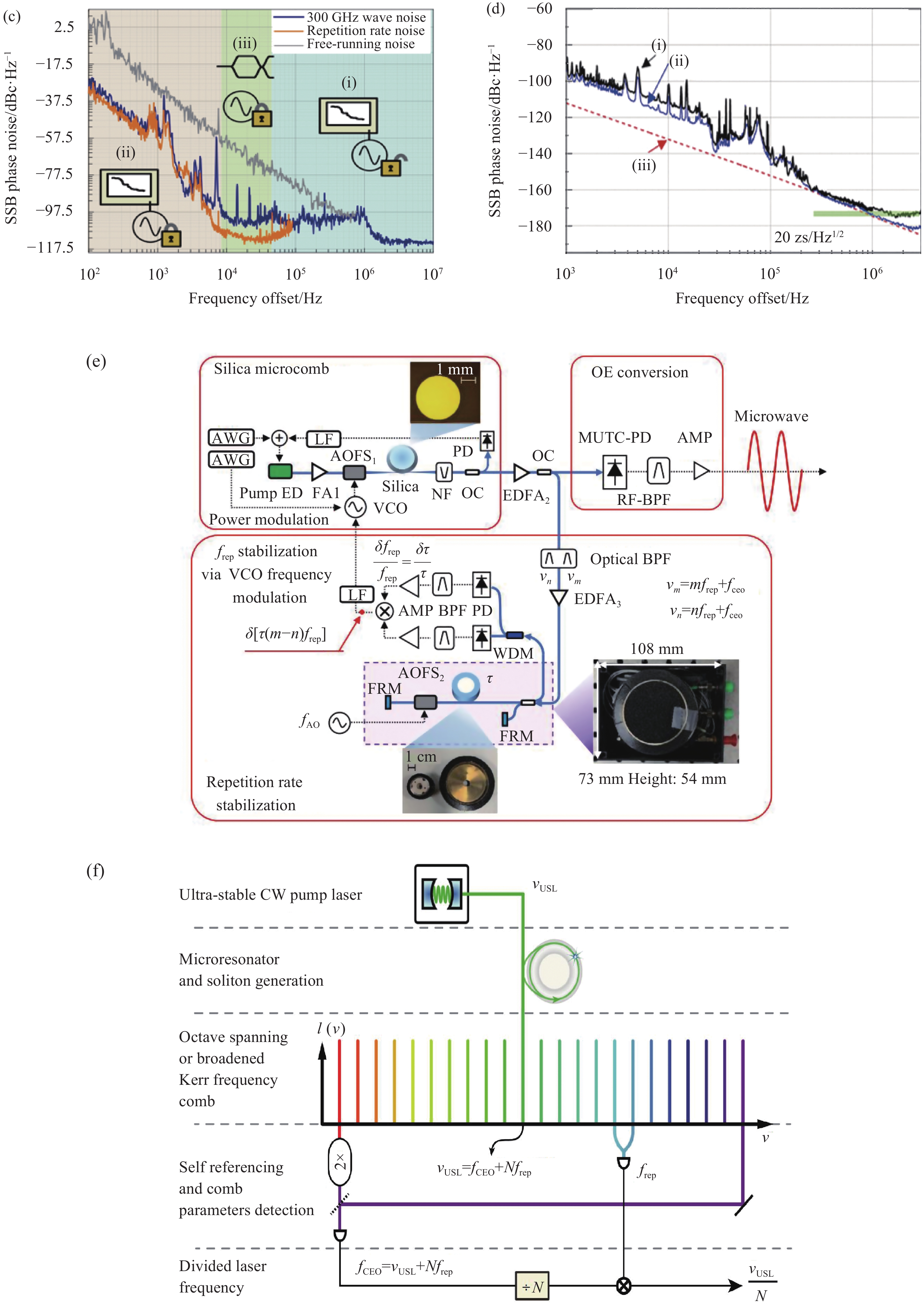HTML
-
高稳定低噪声微波源在现代技术中无处不在,支撑着通信、计算以及雷达和传感系统。大多数信息系统依赖于晶体振荡器作为本地振荡器和频率参考,然而传统电子振荡器的频谱纯度依赖于电学谐振腔的高品质因数,其相位噪声通常会随着载波频率增加而显著恶化。为了克服这一局限性,通过光电子办法产生低相位噪声微波毫米波信号已成为发展趋势,例如:布里渊振荡器[1]、基于锁模光学频率梳的光学频率分频技术[2-3]、双波长激光器拍频[4]等,其频率仅受限于光电探测器的带宽,但是由于激光器以及相关稳定设备和电路体积庞大且复杂,这极大的限制了它们在实验室以外的场所应用。
光频梳自21世纪初问世以来,在多个方面取得突破性应用[5]。特别是在时间频率精密测量领域,光频梳作为链接光频与微波频的相干纽带,可以将微波频上变频至光频进行光学频率的准确测量,也可以将光学频率下变频至微波频,产生纪录性的超低相噪微波信号[2],还可以实现跨倍频的光频锁相。
针对光子振荡器小型化的需求,近年来,得益于基于微谐振腔的激光器以及克尔频率梳的发展,涌现出了多种利用微腔光梳产生低噪声微波信号的方法,包括基于自由运转的微腔光梳方案、基于部分锁定的微腔光梳方案等,使得光子振荡器有望实现低损耗、超高集成度、可量产。
微腔光梳具有重复频率高的特点,可以较容易实现微波毫米波级别的重复频率。孤子状态的微腔光梳,其梳齿与梳齿间的相干性较高,可以直接送入光电探测器产生低相噪微波毫米波信号,如图1所示。与传统光生微波方法相比,微腔光频梳的主要优势体现在其小尺寸、高重频、功耗低、可集成。
-
最近的工作已经展现了基于自由运转微腔光频梳产生微波信号的潜力[6-9]。2015年,来自OEWaves公司的W.Liang等人首次使用自由运转的微腔光频梳进行光生微波实验[6]。通过连续光泵浦品质因数高达108的氟化镁微腔产生克尔梳,在光电探测器上拍频得到了9.9 GHz超高纯度的射频信号,其单边带相位噪声谱如图2(a)所示,达到了−22 dBc/Hz@1 Hz,−125 dBc/Hz@10 kHz,−130 dBc/Hz@1 MHz。其微波信号在低频难以达到量子极限,主要是由于谐振腔的热噪声,以及激光幅度噪声转化到射频信号的相位噪声。

Figure 2. Microwave signal generation based on beat signals of microcombs. (a)-(d) Frequency comb microwave signal generator based on
$ {\mathrm{M}\mathrm{g}}_{2}\mathrm{F} $ microresonator, microcomb microwave signal generator based on Brillouin assisted stabilization, chip-scale microwave signal generator, frequency comb microwave signal generator based on silica disk microresonator respectively. The five lines in Fig.(a), phase noise of microwave signal without and with(red line, (1)) and with(blue line, (2)) a narrow-band filter-placed after the photodetector. Curves(3) and (4) describe theoretically found fundamental thermorefractive and quantum noise of the oscillator, sensitivity of phase noise analyzer is described by curve(5)2021年,南京大学的姜校顺课题组在品质因数为107的二氧化硅微盘腔中,利用布里渊激光的克尔自相位调制,在蓝失谐泵浦条件下产生红失谐的布里渊激光,然后进一步激发重复频率约为10.43 GHz的克尔孤子[7],通过光电探测器拍频得到了低相噪微波源,其单边带相位噪声谱如图2(b)所示,达到了−49 dBc/Hz@10 Hz,−130 dBc/Hz@10 kHz,−149 dBc/Hz@1 MHz。
2020年,瑞士洛桑联邦理工学院的Tobias J. Kippenberg课题组使用大马士革回流工艺制备了表面粗糙度亚纳米级别的超高品质因数氮化硅微环腔,品质因数在107量级,其由近红外连续波激光器驱动,产生孤子脉冲串,该脉冲串通过光电探测器拍频,在K波段产生频率为19.6 GHz,在X波段产生了频率为9.78 GHz的低相噪微波信号[8],其产生的19.6 GHz微波信号单边带相位噪声谱如图2(c)所示,达到了−55 dBc/Hz@1 kHz,−105 dBc/Hz@10 kHz,−125 dBc/Hz@100 kHz。并且研究了激光相位噪声、激光相对强度噪声以及热折射噪声对孤子重复频率的影响。
2021年,加州理工学院的Vahala课题组利用品质因数为3×108盘谐振腔产生了自由运转的克尔孤子,通过光电探测器产生了约15 GHz的微波信号[9],其相位噪声谱如图2(d)所示,达到了−90 dBc/Hz@1 kHz,−140 dBc/Hz@100 kHz。由于光学频率梳的相干性和稳定性对产生的射频信号纯度至关重要,光频梳的性能又很大程度上取决于激发条件,因此这些工作对克尔梳的激发条件进行了详细的研究,发现光频梳拍频后得到的微波信号相位噪声受几个关键因素影响。例如,近场噪声归因于激光相对强度噪声引起的谐振腔热噪声,影响孤子重复频率抖动;腔的失谐噪声会通过拉曼自频移与色散波反冲导致孤子重复频率噪声,使得激光相位噪声转换为微波信号的相位噪声;高非线性微腔有很强的强度到相位噪声转换;此外还有微腔的品质因数Q、散粒噪声等因素。因此,为了得到超低相噪的微波信号,需要低噪声泵浦激光器、高Q微谐振腔、低热涨落,以及通过在特殊的失谐点,利用拉曼自频移和色散波反冲减少光到微波的相位噪声转换。
-
尽管自由运行的微腔光频梳已经证明有可能达到传统方法无法实现的超低定时抖动和微波相位噪声,但是为了在更长的时间范围内抑制重复频率的定时抖动以满足高精度应用,在微腔光频梳中加入部分锁定的方案,可以进一步提高微波信号的频谱纯度[10-13]。2021年,美国IMRA公司的Tomohiro Tetsumoto等人使用品质因数约为1.9×108氮化硅微环腔产生了重复频率为300 GHz的克尔耗散孤子,同时在1558 nm与1530 nm处产生了布里渊斯托克斯激光,通过布里渊斯托克斯激光与克尔梳拍频产生误差信号将3.6 THz光学参考的频率稳定性传递到300 GHz的孤子重复频率上,得到了低相噪高频微波源[10],其相位噪声谱如图3(c)所示,达到了−33 dBc/Hz@100 Hz, −100 dBc/Hz@10 kHz,−115 dBc/Hz@10 MHz。该工作为低噪声的高频信号产生提供了指导方案,有望成为毫米波与太赫兹产生的主要工具。
2020年,韩国科学技术院的Dongin Jeong等人提出了一种基于光纤延迟线干涉仪来测量激光定时抖动的方法,测量了品质因数为1.06×108的硅基楔形微腔产生的22 GHz飞秒脉冲串的定时抖动[11]。并在2022年开发了一种新型高速重复频率调谐机制,通过光纤延时线作为时间参考,对22 GHz微波信号进行噪声抑制[12],其相位噪声谱如图3(g)所示,达到了−74 dBc/Hz@10 Hz,−110 dBc/Hz@1 kHz。
2020年,瑞士洛桑联邦理工学院的Tobias J. Kippenberg课题组将泵浦激光锁相在亚赫兹线宽的超稳连续激光器上,泵浦品质因数为2.4×109的回音壁模式氟化镁微腔产生了重复频率约为14.09 GHz的克尔孤子,通过转移振荡器的方法将超稳激光器的稳定性传递到射频信号上[13],微波信号的相位噪声谱如图3(h)所示,达到了−110 dBc/Hz@200 Hz,−135 dBc/Hz@10 kHz,−150 dBc/Hz@1 MHz。图3(f)展现了转移振荡器产生微波信号的工作原理,这种方法不需要低噪声的光频梳,通过对信号的处理与组合即可在较宽的频率范围内消除噪声,减轻了对超稳参考源的需求,大大简化了失谐稳定机制,展现了其新一代紧凑型光子系统中的良好应用前景。

Figure 3. Microwave signal generation based on the microcomb division frequency. (a) and (c), (b) and (d), (e) and (g), (f) and (h) Millimetre wave oscillator based on Brillouin Stokes division frequency, measurement device of timing jitter based on optical fiber delay line interferometer, microwave signal generator based on optical fiber photonic stabilisation method, microwave generator using a microcomb-based transfer oscillator. The three lines in Fig.(b), measured timing jitter[curve(i)], projected timing jitter from soliton relative intensity noise [curve (ii)] and computed quantum limit of timing jitter [curve (iii)]. The lines in Fig.(d), absolute single-sideband (SSB) phase noise of the 14.09 GHz signal via the Kerr comb transfer oscillator (blue line) and obtained directly from the Kerr comb repetition rate (green line). The red line is the limit inferred from the optical phase noise of the ultra-stable laser
-
当今世界,信息技术日新月异,现代的许多应用对高频谱纯度微波信号的需求日益增长。射电天文学、汽车雷达、大容量通信、原子钟等科学应用最终都将受益于最先进的仪器噪声性能。由于实现高性能的微波信号通常需要复杂的支持系统,超低噪声微波信号发生器一直被看作是实验室中的仪器,随着集成光学频率梳的出现,高精度的本振信号源系统已经逐渐小型化,相较于带有锁定的微波信号装置,基于自由运转的微腔光频梳构建的微波信号发生器更加紧凑,而光源相位噪声转化、谐振腔的热效应等问题是未来实现基于自由运转微腔光频梳的微波信号发生器面临的最大挑战。同时让光梳走出实验室,面向应用场景时还要考虑其稳定性、可靠性等问题。未来将半导体激光器与光子芯片直接集成产生光梳,并探索一种新的机制让其稳定工作,这种兼备鲁棒性与高性能的方案是光学频率梳技术走出实验室的重要一步,有希望能够为低相位噪声商用仪器的集成化、稳定化和可移动的微波源提供新的解决方案,为信息科学的发展打下坚实的基础。














 DownLoad:
DownLoad:



